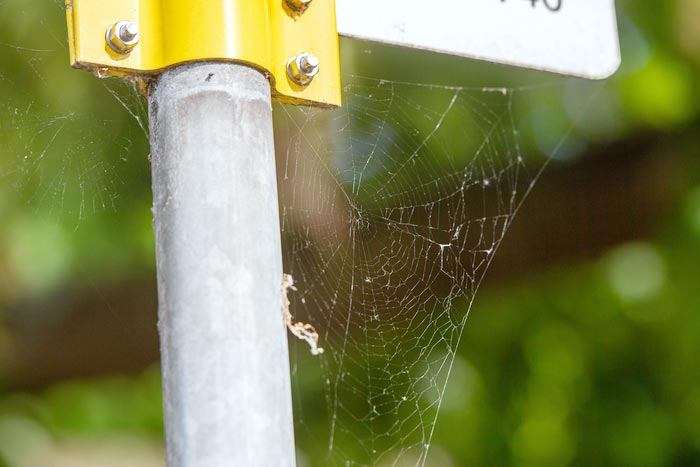Catching microplastics with spider webs

A research team of the University of Oldenburg, Germany, has for the first time examined spider webs collected at bus stops on inner-city streets for microplastics. They found varying levels of plastic contamination, including tyre wear, depending on traffic levels. Sampling spider webs for microplastics may provide an easy means for environmental monitoring of urban air, the team concludes.
Credit: Daniel Schmidt/ University of Oldenburg
A study by a research team of the University of Oldenburg, Germany, reveals that spider webs mirror varying levels of microplastic contamination of urban air.
Flies, mosquitoes, dust and even microplastics – spider webs catch things flying through the air. Researchers at the University of Oldenburg, Germany, have now for the first time examined the webs for microplastics on inner-city streets with varying levels of traffic. The team mainly found the plastic PET, presumably from textiles, as well as particles from the abrasion of car tyres and polyvinyl chloride (PVC). The amounts of plastic particles found depended on the location. Examining spider webs, the team concludes, is a simple and inexpensive means of monitoring urban air pollution by microplastics and can help identifying particularly polluted areas. The findings have been published in the journal Science of the Total Environment.
“Spiders are found all over the world, including in cities. Their sticky webs are an ideal trap for anything that floats through the air,” explains Dr Barbara Scholz-Böttcher. The microplastics expert at the University’s Institute of Chemistry and Biology of the Marine environment (ICBM) was head of the study. Previous studies have shown that pollutants such as heavy metals or magnetic particles get stuck in the webs, she adds. “However, no one has yet examined spider webs for microplastics,” says the geochemist – even though the air we breathe is increasingly contaminated with microplastics.
To find out whether microplastics can be detected in spider webs and whether there are certain distribution patterns, the team collected spider webs from the upper area of semi-covered bus stops at different times. The bus stops were located along roads with different levels of traffic in the city of Oldenburg in north-western Germany. The samples were prepared in the laboratory and the particles adhering to the webs were concentrated on filters.
Fibres from textiles and soot particles
The team first examined the filters microscopically and found, for example, fibres presumably stemming from textiles, as well as soot particles. They then heated the samples at very high temperatures in the absence of oxygen (pyrolysis) and separated the resulting plastic fragments using a gas chromatograph. A downstream mass spectrometer made it possible to assign and determine the different types of plastic.
The result: “All the spider webs were contaminated with microplastics,” reports Isabel Goßmann, who was involved in the study as part of her PhD-thesis. In some cases, the plastic content even accounted for a good tenth of the total weight of a web. Almost 90 per cent of the plastic consisted of PET (polyethylene terephthalate), PVC and material from car tyres. The proportion of tyre debris varied greatly – depending on the traffic on the adjacent road.
Simple alternative for assessing microplastic contamination in the air
“Our results also indicate that the abrasion of road markings is another important source contributing to the microplastic load along roads,” explains Scholz-Böttcher. The researchers also found evidence that the small plastic particles accumulate surprisingly quickly in the spider webs. According to Scholz-Böttcher, the method represents a simple alternative to complex measurements for comparing the microplastic content present in the immediate ambient air. This can be particularly important in the context of further toxicological investigations.
Journal: Science of The Total Environment
DOI: 10.1016/j.scitotenv.2022.155008
Method of Research: Observational study
Subject of Research: Not applicable
Article Title: Plastic in the air?! – Spider webs as spatial and temporal mirror for microplastics including tire wear particles in urban air
Article Publication Date: 2-Apr-2022
COI Statement: none
All latest news from the category: Ecology, The Environment and Conservation
This complex theme deals primarily with interactions between organisms and the environmental factors that impact them, but to a greater extent between individual inanimate environmental factors.
innovations-report offers informative reports and articles on topics such as climate protection, landscape conservation, ecological systems, wildlife and nature parks and ecosystem efficiency and balance.
Newest articles

A universal framework for spatial biology
SpatialData is a freely accessible tool to unify and integrate data from different omics technologies accounting for spatial information, which can provide holistic insights into health and disease. Biological processes…

How complex biological processes arise
A $20 million grant from the U.S. National Science Foundation (NSF) will support the establishment and operation of the National Synthesis Center for Emergence in the Molecular and Cellular Sciences (NCEMS) at…

Airborne single-photon lidar system achieves high-resolution 3D imaging
Compact, low-power system opens doors for photon-efficient drone and satellite-based environmental monitoring and mapping. Researchers have developed a compact and lightweight single-photon airborne lidar system that can acquire high-resolution 3D…





















